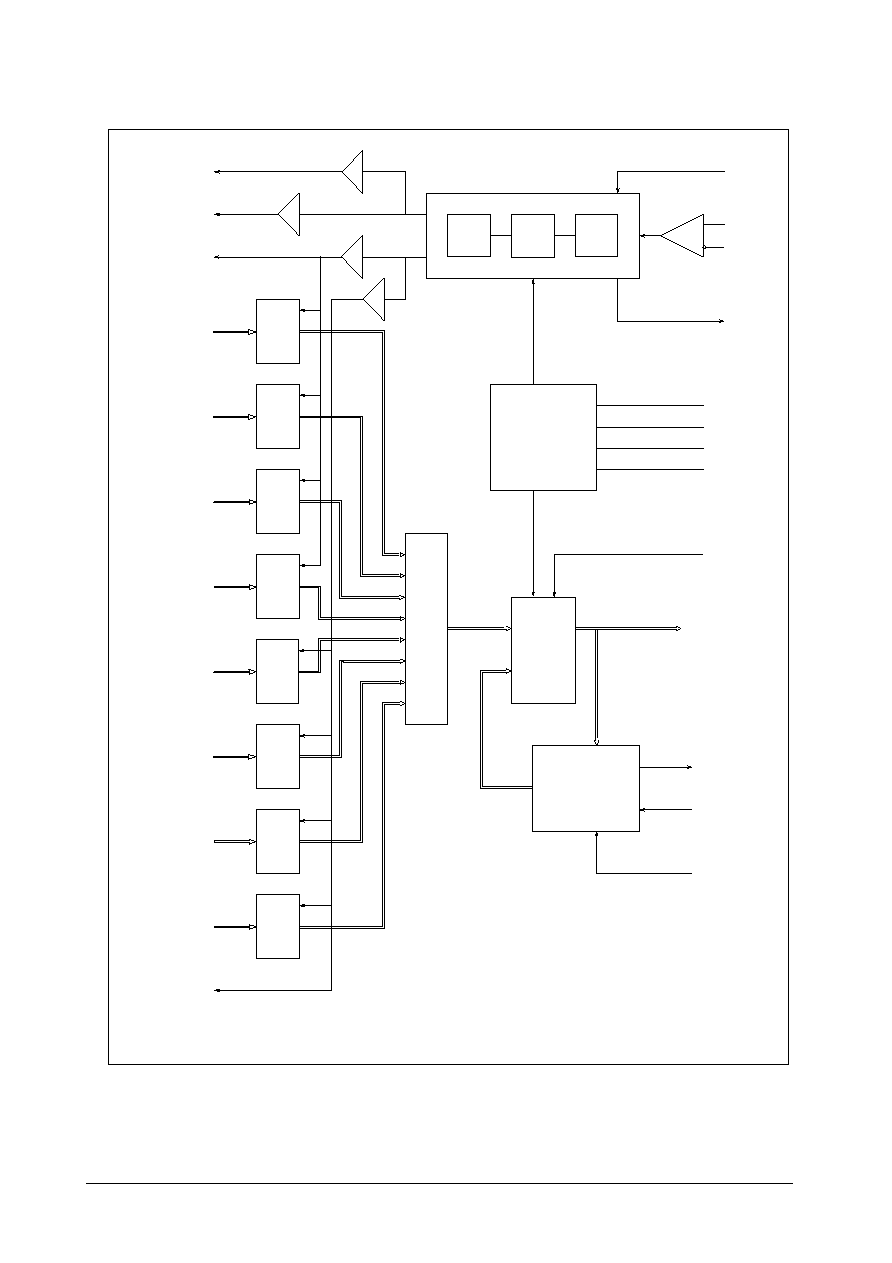 | –≠–ª–µ–∫—Ç—Ä–æ–Ω–Ω—ã–π –∫–æ–º–ø–æ–Ω–µ–Ω—Ç: SSSB152 | –°–∫–∞—á–∞—Ç—å:  PDF PDF  ZIP ZIP |

- 1 -
Swindon Silicon Systems Limited
Jan 96
SSSB152
Byte Multiplexer
SDH Product Range
∑ High performance Silicon Bipolar process
∑ Eight CMOS compatible byte-wide STM1 input ports
∑ Byte-wide ECL100k compatible output port
∑ Interfaces between SSSM112 and SSSB148
∑ Built in scrambling and parity circuits
∑ Built in clock and frame pulse generators
∑ Twin power supply (-5 V & +5V)
∑ Low dissipation (1.55W)
∑ 132 pin gull-wing ceramic package
∑ Meets ITU-T recommendations
Byte Multiplexer
FEATURES
The SSSB152 accepts eight byte-wide input channels (STM1 frames in byte parallel form) at 19.44MByte/s and
multiplexes these onto one byte-wide output channel at 155.52MByte/s. The device includes circuits for parity
generation and scrambling for STM16 or STM64 frames in accordance with the ITU-T recommendations. The
SSSB152 also provides clock and frame synchronisation signals for SSSM112 STM1 Adapter devices.
Two SSSB152 devices and one SSSB148 16:1 multiplexer device form a circuit which merges 16 channels carrying
STM1 frames in byte parallel form into one STM16 serial data stream at 2.48832GBit/s.
Eight SSSB152 devices and a 10GHz 64:1 multiplexer form a circuit which merges 64 channels carrying STM1
frames in byte parallel form into one STM64 serial data stream at 9.95328GBit/s.
FUNCTIONAL OVERVIEW
SSSB152
DATE CODE
The SSSB152 is a 155.52MHz byte-wide 8:1 multiplexer, with additional features to allow it to be used in an STM1
to STM16 or an STM1 to STM64 multiplexer applications.
Pin 1
Top View

SSSB152
Byte Multiplexer
- 2 -
Swindon Silicon Systems Limited
Jan 96
STM1 - STM16 Multiplexer Block Diagram
SSSM
112
SSSB
151
SSSM
112
SSSB
151
SSSM
112
SSSB
151
SSSM
112
SSSB
151
SSSM
112
SSSB
151
SSSM
112
SSSB
151
SSSM
112
SSSB
151
SSSM
112
SSSB
151
1
3
5
7
9
11
13
15
SYNCBO2
MCK2
STMIA
STMIB
STMIC
STMID
STMIE
STMIF
STMIG
STMIH
SYNCBO1
MCK1
SSSB152
MASTER
SSSM
112
SSSB
151
SSSM
112
SSSB
151
SSSM
112
SSSB
151
SSSM
112
SSSB
151
SSSM
112
SSSB
151
112
SSSB
151
SSSM
112
SSSB
151
SSSM
112
SSSB
151
2
4
6
8
10
12
14
16
SYNCBO2
MCK2
STMIA
STMIB
STMIC
STMID
STMIE
STMIF
STMIG
STMIH
SYNCBO1
MCK1
SSSB152
SLAVE
STM1
INPUTS
8x
50
SYNCAI
POUT
B1ENB
MSA
STM16_64
MSB
MSC
SCRB
SYNC IN
n/c
low
low
x
x
50
10n
10n
V
TT
V
TT
CKINB
CKIN
MSTM7
MSTM0
PIN
SYNCAO
SYNCAI
POUT
MSA
MSB
MSC
SCRB
CKINB
CKIN
MSTM7
MSTM0
PIN
SYNCAO
x
x
high
low
low
n/c
10n
10n
STM16_64
B1ENB
SSSB148
D15
D8
D7
D0
Q
QB
CK
CKB
TCK
ICK
100
V
TT
100
V
TT
50
8x
50
STM16
OUTPUT
2.48832 GHz
CLOCK IN

SSSB152
Byte Multiplexer
- 3 -
Swindon Silicon Systems Limited
Jan 96
STM1 - STM16 Multiplexer FUNCTIONAL DESCRIPTION
This description of a complete STM1 to STM16 multiplexer is included to help understand the operation of the
SSSB152 device.
The block diagram shows a complete STM1 to STM16 multiplexer. This multiplexer combines sixteen STM1 serial
data streams at 155.52MBit/s onto one STM16 serial data stream at 2.48832GBit/s. A set of devices to perform the
retiming and reframing of the pleisiochronous STM1 data streams, and to perform the multiplexing functions onto
the STM16 serial data stream is available from Swindon Silicon Systems.
An SSSB151 and an SSSM112 device are used for each STM1 input channel to retime and reframe the
pleisiochronous STM1 155.52MBit/s serial data streams into synchronous, frame aligned, byte-wide 19.44MByte/s
parallel data streams. Two SSSB152 devices and one SSSB148 device are used to multiplex the sixteen STM1
parallel data streams into one STM16 serial data stream at 2.48832GBit/s.
The inputs to the sixteen SSSB151 clock and data receiver devices are the sixteen pleisiochronous STM1 serial data
streams. Each SSSB151 device accepts the STM1 serial data stream in either 155.52MBit/s NRZ data format or
311.04MBaud CMI data format. Each SSSB151 recovers the inbound STM1 clock signal, retimes the data to that
clock signal, then outputs the data in byte-wide parallel form with an associated 19.44MHz clock. The outputs from
the SSSB151 devices are pleisiochronous STM1 data streams in byte parallel form at 19.44MByte/s for the SSSM112
STM1 Adapter devices.
The sixteen SSSM112 devices process the STM1 data in byte parallel form at a clock rate of 19.44MHz. Each
SSSM112 performs the clock synchronisation and frame alignment needed to allow the sixteen pleisiochronous
STM1 channels to be multiplexed onto one STM16 channel. STM1 data is clocked into each SSSM112 by a
19.44MHz clock signal which is derived by the associated SSSB151 device from the inbound STM1 serial data
stream. STM1 frames are clocked out of each SSSM112 device by 19.44MHz clock and 8kHz frame synchronisation
signals which are derived by the SSSB152 and SSSB148 devices from the 2.48832GHz STM16 clock. The outputs
of the SSSM112 devices are STM1 frames in byte parallel form at 19.44MByte/s which are in clock synchronism
and frame alignment with each other.
The two SSSB152 devices are byte-wide 8:1 multiplexers which take in STM1 frames in byte parallel form at
19.44MByte/s, and have byte-wide outputs at 155.52MByte/s. The SSSB152 devices multiplex the STM1 channels,
generate parity and perform the scrambling needed for the STM16 frames. One SSSB152 device acts as the Master
device, this device performs the multiplexing of the odd numbered STM1 channels (1, 3, 5, 7, 9, 11, 13, 15). The
other SSSB152 acts as a Slave device, this device multiplexes the even numbered STM1 channels (2, 4, 6, 8, 10, 12,
14, 16). These devices also divide the 155.52MHz clock from the SSSB148 device to form the 19.44MHz clock and
8kHz (125
µ
s) frame synchronisation signals for the SSSM112 devices. Connections between the two SSSB152
devices maintain synchronisation of the clock and frame dividers in each SSSB152 device, and allow the correct
parity to be generated and inserted into the output frame. Outputs from the SSSB152 devices are 8 STM1 channels
multiplexed together in byte-wide parallel form at 155.52MByte/s.
The SSSB148 device is a 2.5GHz 16:1 Multiplexer which combines the two byte-wide 155.52MByte/s parallel data
streams from the SSSB152 devices onto one 2.48832GBit/s STM16 serial data stream. The SSSB148 also divides
the 2.48832GHz clock down to 155.52MHz for the SSSB152 devices.
Note: Although this description is of an STM1 to STM16 multiplexer, the SSSB152 device also has features which
allow 8 devices (one Master and 7 Slaves) to be used together with a 10GHz 64:1 Multiplexer to form an STM1 to
STM64 multiplexer.

SSSB152
Byte Multiplexer
- 4 -
Swindon Silicon Systems Limited
Jan 96
˜
270
˜
9
˜
8
CLOCK DIVIDER
SYNCAO
CKINB
CKIN
SYNCAI
SYNCBO1
SYNCBO2
MCK2
STMIA
{7:0}
LA
TCHES
STMIB
{7:0}
LA
TCHES
STMIC
{7:0}
LA
TCHES
STMID
{7:0}
LA
TCHES
LA
TCHES
LA
TCHES
LA
TCHES
LA
TCHES
STMIE
{7:0}
STMIF
{7:0}
STMIG
{7:0}
STMIH
{7:0}
MCK1
MUL
TIPLEXER
STM16_64
MSA
MSB
MSC
CONTROL
LOGIC
SCRAMBLER
PARITY
B1ENB
PIN
POUT
SCRB
MSTM
7:0
SSSB152 Block Diagram

SSSB152
Byte Multiplexer
- 5 -
Swindon Silicon Systems Limited
Jan 96
SSSB152 FUNCTIONAL DESCRIPTION
The SSSB152 device is designed as part of a chip set for a complete STM1 to STM16 (16:1) or STM1 to STM64
(64:1) multiplexer.
The main function of the SSSB152 device is to multiplex eight STM1 frames in byte-wide parallel form at a clock
rate of 19.44MHz onto one byte-wide parallel data stream at a clock rate of 155.52MHz. The device provides parity
generation and scrambling for STM16 or STM64 frames in accordance with the ITU-T recommendations. The
device also divides the 155.52MHz input clock to form the 19.44MHz clock and 8kHz (125
µ
s) frame
synchronisation output signals which may be used for frame alignment of the STM1 channels external to the
SSSB152.
A complete STM16 or STM64 multiplexer requires multiple SSSB152 devices, a Master device and either one or
seven Slave devices respectively. The SSSB152 has configuration control inputs which vary the operation of the
device depending on whether the device is in an STM16 or STM64 multiplexer application, and whether it is in a
Master or a Slave position. Connections between the SSSB152 devices maintain synchronisation of the clock and
frame dividers in each SSSB152 device, and allow the correct parity to be generated and inserted into the output
frame.
Data Path
The data inputs to the SSSB152 consist of eight ports, each port having eight input pins. The ports are identified as
STMIA{7:0} to STMIH{7:0}. For SDH applications, each port carries STM1 frames in clock synchronism and
frame alignment with each other. Data on all 64 inputs is latched into the SSSB152 by the falling edge of the MCK
signal. MCK is a 19.44MHz clock output of the SSSB152. The Swindon Silicon Systems SSSM112 STM1 Adapter
devices interface directly with the 19.44MHz data inputs, clock outputs and frame pulse outputs of the SSSB152.
The data outputs of the SSSB152 device are identified as MSTM{7:0}. Data is clocked out by the rising edge of
the 155.52MHz CKIN clock. Output data cycles round the input ports STMIA{7:0} to STMIH{7:0} in alphabetical
order at 155.52MHz. If inputs SCRB and B1ENB are both high, the data is unmodified. The action of inputs SCRB
and B1ENB is described below. The Swindon Silicon Systems SSSB148 2.5GHz Multiplexer device interfaces
directly with the 155.52MHz data outputs and clock input of the SSSB152.
Scrambling
The SSSB152 includes scrambler circuits. Scrambling is enabled when the SCRB control input is low. Scrambling
operates on all bits of the STM16 or STM64 frames except during the Regenerator Section OverHead (RSOH).
Scrambling operates in a way which is functionally equivalent to a frame synchronous bit serial scrambler of
sequence length 127 operating on the STM16 or STM64 frames at the line rate. The SSSB152 uses an equivalent
parallel scrambler. Scrambling conforms to ITU Rec. G709.
For each SSSB152 device in an STM16 or STM64 multiplexer, the polynomial and start code used for scrambling
depends on the state of the four configuration control inputs STM16_64, MSA, MSB, and MSC. The STM16_64
input sets the correct polynomial for either an STM16 or an STM64 multiplexer. The MSA, MSB, and MSC inputs
set the correct start code for the device position, i.e. whether the device is in a Master or Slave position, or which
of the seven Slave positions in the case of the STM64 multiplexer application.




